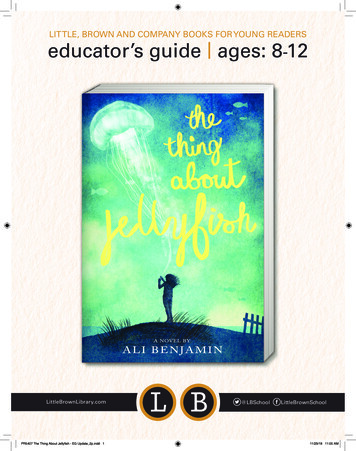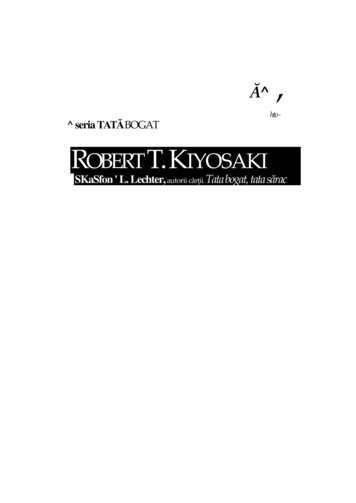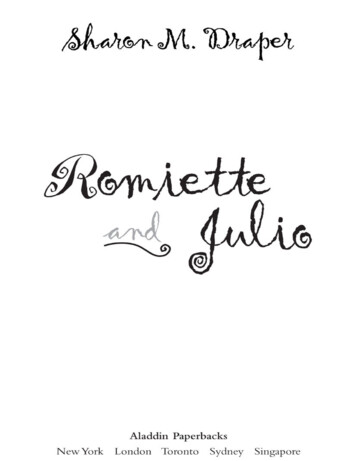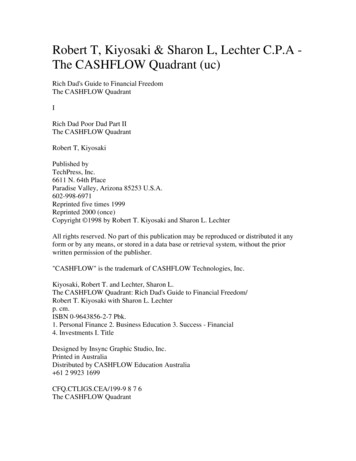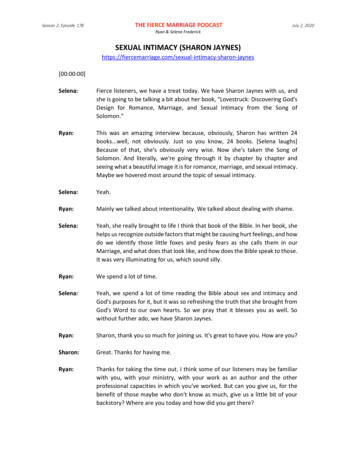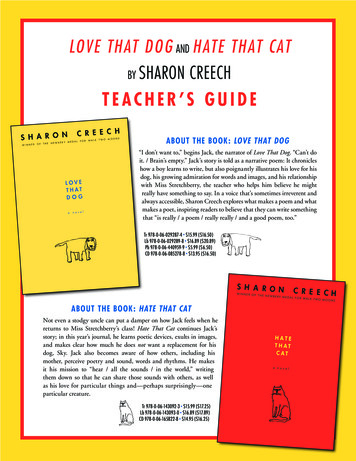
Transcription
Love That Dog and Hate That Catby Sharon CreechTeacher’s GuideAbout the Book : Love That Dog“I don’t want to,” begins Jack, the narrator of Love That Dog. “Can’t doit. / Brain’s empty.” Jack’s story is told as a narrative poem: It chronicleshow a boy learns to write, but also poignantly illustrates his love for hisdog, his growing admiration for words and images, and his relationshipwith Miss Stretchberry, the teacher who helps him believe he mightreally have something to say. In a voice that’s sometimes irreverent andalways accessible, Sharon Creech explores what makes a poem and whatmakes a poet, inspiring readers to believe that they can write somethingthat “is really / a poem / really really / and a good poem, too.”Tr 978-0-06-029287-4 15.99 ( 16.50)Lb 978-0-06-029289-8 16.89 ( 20.89)Pb 978-0-06-440959-9 5.99 ( 6.50)CD 978-0-06-085278-8 13.95 ( 16.50)About the Book : Hate That CatNot even a stodgy uncle can put a damper on how Jack feels when hereturns to Miss Stretchberry’s class! Hate That Cat continues Jack’sstory; in this year’s journal, he learns poetic devices, exults in images,and makes clear how much he does not want a replacement for hisdog, Sky. Jack also becomes aware of how others, including hismother, perceive poetry and sound, words and rhythms. He makesit his mission to “hear / all the sounds / in the world,” writingthem down so that he can share those sounds with others, as wellas his love for particular things and—perhaps surprisingly—oneparticular creature.Tr 978-0-06-143092-3 15.99 ( 17.25)Lb 978-0-06-143093-0 16.89 ( 17.89)CD 978-0-06-165822-8 14.95 ( 16.25)
Teacher’s Guide forLove That Dog and Hate That CatTeaching Poetry: How to Integrate Love That Dog and Hate That Cat into Your Poetry UnitJack’s voice is original, but his struggle to understandand appreciate poetry is not unusual: Your students willconnect with him as a narrator, making it easy to incorporateLove That Dog and Hate That Cat into your poetry unit. Inaddition to reading one or both books, consider the following: Use this Teacher’s Guide to facilitate your lesson plans. Thisguide is filled with ideas, discussion questions, writing activities,and other valuable suggestions for teaching poetry and using thesetwo books in your classroom. Keep running lists. When you and your students find examplesof onomatopoeia, alliteration, simile, or other figures of speech,write them onto poster-size paper. Put these lists on the classroom walls and allow them to be living documents—encouragestudents to add to them throughout the poetry unit. Have fun. Notice that Jack always refers to poets as “Mr.” or “Miss,”and recall his bliss when Mr. Walter Dean Myers responds tohis letter. (Think also of his feelings for Miss Stretchberry!) Bysharing your enthusiasm for language, you will hopefully inspirethe same reverence and excitement in your students. Poll students before and after reading. Survey studentsbefore reading to determine prior knowledge. What poems arethey familiar with? What words do they use to describe poetry?Repeat your survey after reading, and discuss how responses havechanged.Teaching Poetry: Tips for Making Poetry Accessible and Fun for Students Build a wall of fame. On a wall in your classroom, post pictures Feel the rhythm. Jack learns to tap out the rhythm of a poem;of the poets your students will be reading. Next to each photo,include an interesting or funny quote, anecdote, or detail aboutsomething that the author did when he or she was your students’age. Consider unveiling the portraits on a Poets’ Day, like the oneJack describes in Hate That Cat.your students will enjoy doing the same. Choose poems witha steady beat and read them aloud, emphasizing the stressedsyllables. Allow students to “drum” along with you. As anextension, encourage students to investigate the connectionsbetween poetry and music. Do their favorite musical artists usemeter in their lyrics? What about rhyme or alliteration? Celebrate Nonsense Day. Put feathers in your students’ brains andmake their ears frizzle by immersing them in playful language!Bring in a collection of objects so that students can practice“doing” alliteration, as Jack does in Hate That Cat (he writes of a“purple pickle” and “chocolate chalk,” even though those thingsdon’t quite make sense). Consider reading nonsense poems, likeLewis Carroll’s “Jabberwocky,” or creating a list of nonsensewords, like “yipyipabulation.” Host a poetry jam. Perform a poem for your students, high- Use home languages. If your students don’t speak English (orhis bedroom wall, and your students can get inspired by doing thesame thing. Let students choose their favorite poem from LoveThat Dog, Hate That Cat, or your poetry unit. Then have eachstudent rewrite his or her selected poem on poster board while alsoillustrating or otherwise decorating the poem so that it becomesa piece of art.standard English) as a first language, expose them to poetry intheir native tongue. Share poems that use a mix of languages ordialects, or ones that interweave slang with formal language. Show that it’s okay. Discuss with your students Jack’s early reactions to poetry and emphasize that it’s all right not to “get” a poemthe first time you read it. Ask students to track Jack’s reactions toWilliam Carlos Williams, which go from a total lack of understanding to imitation and homage. Tell students about a poemthat you didn’t like at first but which eventually grew on you. T each useful annotations. Show your students how physicallymarking a poem as they read can help them understand it.Helpful symbols to learn might include a question mark (for something that is confusing), an eye (for a striking image), or an ear(for something that sounds good). Encourage students to identifypassages where they can make a connection to themselves, othertexts, or the world at large.lighting rhythm and rhyme. Then ask each student to memorizea favorite poem (or at least a portion of one) and to perform itfor the class. Alternatively, search online for recordings of classicauthors reading their works or for more contemporary poetryslams. Play the recordings for your students. Create poetry posters. Jack tacks a copy of his favorite poem to Publish best work. Type your students’ original work or givethem the time and resources to type their poems themselves. LikeMiss Stretchberry does, allow students some control over creativeaspects of the publishing process. Can poems be put on specialpaper or displayed in a special spot? Post the typed poems in theclassroom.
Teacher’s Guide forLove That Dog and Hate That CatTeaching Poetry: Ideas for Adding Poetry to Your Daily Curriculum Provide journal time. Jack uses his journal to react to the poems Read poems for fluency. Repeated readings of a text help studentshe is reading and to experiment with his own writing. Providestudents with a poetry journal and regularly scheduled writingtime, starting with short increments and building up to longerperiods. Use your responses to ask guiding questions and directstudents to other poems that may inspire.gain oral fluency, and poems are often just the right length forfluency practice. Assign a new poem each week and ask studentsto read it aloud as you time them for one minute. Students shouldmark the last word that they read each day. The goal is for themto get a little farther with every reading, and you can help studentscreate a tracking sheet so that they can record how many wordsthey’re able to read. Students should see steady progress in fluencyas the year goes on. Shine the spotlight on the author’s chair. Give the best seatin the house (a high stool, a comfy armchair, or even your seat)to students for a few moments each day so that they can shareoriginal work. Read out loud. Share a short poem with your students eachmorning. Vary the poems that you read to show students thatpoetry can get them to laugh, help them picture faraway places,remind them of their own lives, or just sound good, “beat-beatbeating” in their ears. Research a poet of the day. Assign each student a day during yourpoetry unit to share background information about a chosen poet.Students should also share an example of that poet’s work andbring in visual aids or other interesting supplementary materials. Connect to other subject areas. Use poetry as a way to introducenew topics in all curricular areas. You might include poemsfrom other cultures or ones about historical events for socialstudies, while descriptive poems about plants or animals can piquestudents’ interest in science. There are even poems about math! Work your technique. Challenge students to employ higher-levelthinking about new concepts while experimenting with language.Use alliteration as a way to cement concepts in other subjects.If you’re studying ancient history, for example, which of your studentscan come up with the most accurate R word to characterize theRomans? The Rowdy Romans? The Republican Romans? Whatelse? Can students summarize a new science concept in haiku, orcreate a rhyme to help them remember a significant date in history?Understanding Poetry: Terms and ConceptsAlliteration—the repetition of a beginning sound.Examples from Hate That Cat: “creepy cats,” “ delightful dog.”Assonance—the repetition of vowel sounds.Examples from Hate That Cat: “clasps the crag,” “sea beneath”(from “The Eagle” by Alfred, Lord Tennyson).Concrete poetry—as Jack says in Love That Dog, a concrete poem is when“the words / make the shape / of the thing / that the poem / is about.”Example from Love That Dog: “The Apple” by S. C. Rigg.(By the way, S. C. Rigg is a pseudonym for Sharon Creech!)Consonance—the repetition of similar sounds, especially consonantsounds, at the end of words.Example from Love That Dog: “shaggy straggly.”Free verse—poetry that doesn’t rhyme or have a regular meter or rhythm.Most of Jack’s poems in Love That Dog and Hate That Cat are free verse.Imagery—words an author uses to help the reader visualize and imagine withthe senses.Example from Hate That Cat: “pouncing with her cactus claws.”Metaphor—a comparison that suggests that one thing is the same asanother; metaphors often use a being verb, like “is” or “was,” to equatethe two things.Example from Hate That Cat: “The black kitten / is a poet /L E A P I N G / from / line / to / line.”Narrative poetry—a poem that tells a story.Love That Dog and Hate That Cat are both narrative poems; each onetells the tale of a year in Jack’s life through his journal entries.Onomatopoeia—words that imitate sounds.Examples from Hate That Cat: “ buzz buzz buzz,” “pop! pop!,”“tinkle and trickle.”Prose—writing that is not poetry.Example from Hate That Cat: Jack tries writing prose but says in hisSeptember 21st journal entry: “I hate to read, those long lines, and Idon’t want, to write them, either.”Rhyme—two or more words that end with the same sound.Example from Love That Dog: “bright” and “night.”Rhythm—a repeating pattern of sounds and syllables.When Jack uses his fingers to tap “HARD-soft HARD-soft / slow andthen faster” in Hate That Cat, he is helping his mother feel the rhythmof “Black Cat” by Christopher Myers.Simile—a comparison that says that one thing is like another; a similecontains the word “like” or “as.”Example from Hate That Cat: “The chair in my room / is like apleasingly plump momma.”Symbol—a word or object that stands for something else.Example from Hate That Cat: When Uncle Bill criticizes Jack’spoems, he becomes a symbol for the critics who don’t “get”William Carlos Williams’s poetry.
Teacher’s Guide forLove That Dog and Hate That CatDiscussion Questions: Love That Dog1. In his first journal entry, Jack says that “boys / don’t write poetry.”Do you agree? What kind of a person do you picture when youimagine a poet?6. Look back at Jack’s poems about his dog, Sky. How do thesepoems build on each other? How does Jack reuse his own words,and where can you find lines that were inspired by other poets?2. Jack’s beliefs about poetry change throughout the year. What doyou believe about poems? What makes something a poem? Howare poems different than stories and other kinds of writing?7. Jack wants to cut the final four lines of his poem from January24th. Why? Do you think the poem is stronger with the final linesor without? Explain.3. When he’s first learning to write poetry, Jack borrows a lot of ideasfrom other poets’ works. Why? Does borrowing from others helphim to develop his own style? Where do you draw the line betweenbeing inspired by someone else and copying his or her work?8. What makes Miss Stretchberry a good teacher? How does sheteach? What kinds of things do you imagine that she writes inJack’s journal? What does she do to build Jack’s confidence?4. Jack feels nervous about having his work displayed in the classroom. Why does he want his early poems to be anonymous? Howdoes he expect his classmates to react? Do you ever have a hardtime sharing your work? Why?9. Which of Jack’s poems is your favorite? How does it make you feel?Describe Jack’s writing style and compare it with your own.10. Are you at all similar to Jack? Discuss Jack’s growth as a readerand as a writer using quotes from the book. Which one of hisstatements about poetry most echoes your own feelings?5. Jack is enchanted with how Walter Dean Myers’s voice soundswhen he reads aloud. What makes someone good at reading outloud? Try reading aloud your favorite poem from Love That Dog.How does it sound different from when you read it in your head?Discussion Questions: Hate That Cat1. U ncle Bill says that Jack’s poems are “just / words / coming /out.” Do you agree? Are poems better when they include rhymes,metaphors, and other fancy language tricks? Why or why not?2. Miss Stretchberry tells Jack that alliteration and onomatopoeiacan enrich a poem and that “they can also make a poem / soundpurple.” What does she mean? Is a poem sounding purple a goodthing? Why does Miss Stretchberry use the word purple?7. Jack’s poetry changes when he shares it with his mother. Discussthe things that he does to help her feel the sounds in his words.How does onomatopoeia become more important to Jack as thestory progresses?8. Reread the poems inspired by William Carlos Williams. Whichone do you think is most effective? If Miss Stretchberry asked youto explain what “so much depends upon,” what would you say?3. Jack likes practicing alliteration but worries that he’s “WRONG”because what he’s written isn’t true. What do you think? Is it okayto write things just because they sound fun, even if they don’tmake sense?9. Love That Dog and Hate That Cat are both narrative poems. Whydo you think Sharon Creech tells Jack’s story using journal entries?How else could she have done it? Is there anything that you don’tknow about Jack that you’d like to find out?4. Jack thinks that writing poetry is easier than writing prose. Whatabout you? How do you feel when you begin a writing assignmentand are faced with a blank page?10. What does Jack appreciate about the poems that Miss Stretchberryintroduces him to? What does each poem teach him? Which ofthe poems at the back of the book is your favorite, and why?5. Describe how Jack’s feelings about Skitter McKitter and the fatblack cat evolve. Why does Jack care about the kitten? How do hisfeelings for Skitter differ from his feelings for Sky?6. Jack’s mother doesn’t speak the way he does. How do we, asreaders, find out that she’s deaf? What imagery does Jack use todescribe her?
Teacher’s Guide forLove That Dog and Hate That CatWriting Activities1. Street music. Jack’s street doesn’t sound like the one in ArnoldAdoff ’s poem, which he reads in Love That Dog. He says that hisstreet has “quiet music / most of the time / whisp / meow / swish.”What does your street sound like? Brainstorm a list of words andsounds, including onomatopoeic words like those introduced inHate That Cat. Use your words to make your own “Street Music”poem.2. Concrete poetry. Jack writes poems that are shaped like the thingsthey describe. Choose something that you see every day and painta picture of it with words. Consider hiding details inside yourpoem, as Jack does when he tucks the black hair among the yellowones in his chair poem in Hate That Cat.3. Apologies. In Love That Dog, Jack’s March 14th apology to MissStretchberry takes an unusual form. Think about a time when youdid something wrong, and write an apology (or excuse?) as a poeticletter to the person you hurt. Is writing an apology poem harder oreasier than apologizing face-to-face?4. Real live people. Even before he meets his hero, Walter DeanMyers, Jack is interested in the people who write poetry. Chooseone of the poets featured in Love That Dog or Hate That Cat.Research the poet’s life and then give a presentation to your classabout what you’ve learned. Also choose a poem by your selectedpoet that does not appear in either of Sharon Creech’s books toshare with your classmates.5. Letters of admiration. Follow Jack’s example and write a letter tothe author of your choice. Tell the author why you love his or herwork and what it means to you. Keep in mind that, should yousend your letter, you may not get a response—as Miss Stretchberrywarns Jack in Love That Dog: “writers are very very very very / busy /trying to write their words.”9. Going outside of the lines. By the end of Hate That Cat, Jack’spoems have started to leap around nearly as much as his kittendoes! Choose a movement that you do every day—throwing a ball,brushing your teeth, climbing the stairs—and write a poem thatdoesn’t stay strictly horizontal; instead, let the words follow themotion. Can you describe the movement without saying explicitlywhat it is? If you give the poem to a friend, can he or she figure outwhat you’ve written about just by reading the words and lookingat the shape?10. Tintinnabulation and other wonderful words. Start a collectionof words that catch your fancy, writing them in a journal so thatyou have them handy for your poems. Consider noting whereyou first heard the word, writing its definition, and adding anillustration. Make sure this journal is not locked up—try outyour wonderful words on your friends!11. Thesaurus treasure hunt. Sometimes words become so common that they lose their impact—words like “cool” or “pretty.”Bury these words for a while and dig into your thesaurus to findappropriate substitutes. See if your classmates can think of othergood synonyms for the too-common words. Make a list and postit in your classroom to encourage your peers to use a wider varietyof words.12. Tell Bill. In Hate That Cat, Uncle Bill dislikes William CarlosWilliams’s poems because he thinks that they are “minor” (notimportant), “faux” (fake), and only about “small moments.”Do you agree with Uncle Bill’s views about what makes a goodpoem? Does Jack? Write a script for Jack to use the next time hesees his uncle, defending his favorite authors and explaining howtechniques like alliteration and onomatopoeia can enrich a poemwithout having to be there every time.6. Poetic comparison. Choose one of Jack’s poems that is inspired byanother poet. How is Jack’s poem similar to the original? Whatwords or phrases does he reuse? How does he rearrange them? Doyou think that his poems are original? Write a paragraph comparing Jack’s poem with its model.7. Inspired by. Select your favorite poem that appears at the end ofLove That Dog or Hate That Cat. Use that poem’s form to write oneof your own. Not sure where to start? Jack gets his start with “TheRed Wheelbarrow,” so give William Carlos Williams’s style a try.8. Upside down and inside out. In Hate That Cat, Jack says that hischair is “like a pleasingly plump momma,” but he’s not sure if his“momma is like a pleasingly plump chair.” Find another simile ineither book and turn it inside out. For example, Jack’s April 26thstatement in Love That Dog that “your brain / feels like / a squashedpea” could change to: “a squashed pea feels like your brain.” Imagine a situation that might lead someone to say this new simile (andwhy that person might be touching your brain!). Start a story or apoem with your r exclusive information on your favoriteauthors and artists, visit www.authortracker.com.To order, please contact your HarperCollins sales representative,call 1-800-C-HARPER, or fax your order to 1-800-822-4090.Prices and availability subject to change without notice.Teaching Guide prepared by Kate Coxon, teacher atSan Antonio Elementary School in San Jose, California.
Teacher’s Guide forLove That Dog and Hate That CatSHARON CREECH25)89))2.95)ip andreview)9)9)00)review)9))el,gereview)ortice.Lyle Rigg)“I love ththe way thatth t eachh book—anyb kbook—isb k i itsit ownjourney. You open it, and off you go. You are changed in someway, large or small, by having traveled with those characters.”—Sharon Creech
Teacher’s Guide forLove That Dog and Hate That CatA Day in the Life of Sharon CreechI love waking up in the house to which we’ve recently moved. I roll out of bed around seven a.m. and goimmediately to the windows, which look out on the yard with tall, old trees and a hill rolling down to a lake. Istudy the sky and the lake and the squirrels and chipmunks. Sometimes it is calm and still out there, sometimeswindy and stormy, but always beautiful.I make a cup of tea, take a shower, and eat breakfast. Then I settle into my offi ce (which also overlooks the lake)and try to stop watching the squirrels and chipmunks and focus on work. Nearly every day, the same squirrel stopsmidway up the tree nearest my window and watches me. He’s very distracting.I check email to see if there is anything urgent to address, and then I try to ignore the piles of paperwork (mail,interviews, requests, preparing for appearances) and turn to whatever story I’m working on. First I’ll reread whatI’ve already written on the story, and then I dive into the next section while I have the rhythm of the words in myhead. I like to get five pages written (on the computer) in the morning.KnowNewAmenoveBloomThatrelatiIn cofor bassistshe aI get out of my chair a lot while I’m writing those five pages—to put the laundry in, make another cup of tea,open the windows, take the laundry out. My brain keeps working while I do these things, so that when I sit backdown, the words are ready to continue. When I finish those five pages, I feel so happy!Time to reward myself: If it’s nice enough weather, I’ll go kayaking with my husband, or putz around the yard, orgo for a walk. Then lunch and a little reading, followed by a precious nap. Those naps have fostered some greatideas. I’ll wake up and discover that the story has been cooking along while I was dozing. Amazing!Back to my office to write a few more pages. Next, I’ll turn to answering mail and returning phone calls. In the lateafternoon, I’ll call my granddaughter (she’s six) and we’ll have a lovely conversation about whatever is on her mind:It might be horses or dimetrodons or her younger brother, whom she calls Boodgiesaurus. I talk to Boodgiesaurus,too, but I can’t understand everything he says. He’s two and loves trucks and trains and elephants. Dozens of picturesof my grandchildren surround my desk; I love them to piecesIn the early evening, my husband and I make dinner and eat; I iron while we watch the news and worry about theworld; and I’ll return to my office and work for a couple more hours. By then my brain is pretty much empty. Inorder to fill it up again for the next day, I look forward to reading and sleeping. Mountains of books topple besidethe bed. So much to choose from!This probably does not sound like a very exciting day, and it’s only typical of the days I am home and not traveling, but to me it’s delicious—time to read and write and be near a lake and time to be with my husband and talk tomy family and friends. Yum.Q: WCA: JrtWaQ: WA: IeMe
goke. Imesake)topsmail,whatmytea,backTeacher’s Guide forLove That Dog and Hate That CatAbout the AuthorKnown for writing with a classic voice and a unique style, Sharon Creech is the bestselling author of theNewbery Medal winner Walk Two Moons and the Newbery Honor Book The Wanderer. She is also the firstAmerican in history to be awarded the CILIP Carnegie Medal for Ruby Holler. Her other works include thenovels Hate That Cat, The Castle Corona, Replay, Heartbeat, Granny Torrelli Makes Soup, Love That Dog,Bloomability, Chasing Redbird, Pleasing the Ghost, and Absolutely Normal Chaos; and three picture books, Who’sThat Baby?, Fishing in the Air, and A Fine, Fine School. These stories are often centered around life, love, andrelationships—especially family relationships.In college, Ms. Creech took her first writing courses and attended writing workshops, which sparked her enthusiasmfor becoming a novelist. Following her studies in college and graduate school, Ms. Creech worked as an editorialassistant before deciding to become a teacher overseas. After spending eighteen years teaching and writing in Europe,she and her husband returned to the United States to live.A Conversation with Sharon Creechd, orreatlateind:rus,uresthey. Insidevelk toQ: What motivated you to return to Miss Stretchberry’s classroom to tell more of Jack’s story in Hate ThatCat?A: Jack’s voice has stayed in my head, more so than other characters’ voices. That may be, in part, because I’vereceived so many letters from students who have read Love That Dog and who write in Jack’s voice. Many oftheir letters suggest sequels about other pets: Love That Gerbil, Love That Turtle, Love That Rabbit, Love ThatWorm (!). I thought it might be intriguing to follow up with an animal that Jack would not like—at least notat first.Q: What has most pleased you about the responses from teachers, librarians, and children to Love That Dog?A: I have been stunned by the sheer number of responses and by the enthusiasm for poetry. Many, many teachers have sent collections of their students’ poems—poems that are “inspired by Jack” or by other poets thatMiss Stretchberry has introduced. Over and over, so many students say, “I was like Jack. I didn’t like poetryeither until I read this book.” To see students interested in poetry is beautiful!Q: HMA: ItorhdIonQ: WwA: TdwwsawthIanstwtow
thefirsttheDog,Who’sandasmorialope,ThatI’veny ofThatnotDog?achthatetryTeacher’s Guide forLove That Dog and Hate That CatA Conversation with Sharon CreechQ: How do you go about selecting the poems thatMiss Stretchberry uses in Hate That Cat?A: I try to imagine what Miss Stretchberry might chooseto encourage Jack—poems with strong sounds andrhythms and images, and poems about cats. When Idon’t readily know of a poem that seems appropriate,I trawl through my own poetry library until I findone that resonates.Q: What are the most interesting aspects of being awriter?A: The most interesting part for me is the writing:discovering what will pop out next, listening towhat the story wants to be, and shaping that story,word by word, page by page. I think the best passages come when I “get out of the way” entirely,when I immerse in the language and rhythm ofthe words and let them surface as they will.I also love doing Readers Theatre with studentsand with my colleagues because this allows thestories (not just mine, but other writers’ stories aswell) to be enjoyed in a whole new way. To be ableto see and hear the audience’s response to thewords is fascinating.(continued)Q: You’ve written novels in verse, novels that include plays, and standard prose. Do you knowbefore you begin writing what shape a story willtake?A: The idea for a story and the form of the story seemto arrive together, without conscious planning.Sometimes a story seems to want to be told in prose,sometimes verse, occasionally drama. I love the surprise of watching the form unfold, and I enjoy playing with the form, stretching it, to see how it willbest suit the story.Q: Thinking across all of your books, which of yourcharacters would you say is most like you?A: This is hard to say. I think that all of my maincharacters—from Salamanca to Zinny to Domenicato Sophie to Jack to Rosie to Dallas and Floridaand Pia and Enzio, etc.—are like me in some ways,and if you squished them all together, you mightget a good sense of me.Q: What other exciting projects are you currentlyworking on? Will we be hearing from Jack andMiss Stretchberry again in the future?A: Right now I’m revising a book called The Unfinished Angel, which to me is very, very funny. I’vespent some time in Switzerland this year, and thestory is set in a stone tower in the mountains ofSwitzerland.As for Jack and Miss Stretchberry: I don’t know ifthey will surface again. I know Jack will be talkingin my head, so it depends, I suppose, on how insistent he becomes.
Teacher’s Guide forLove That Dog and Hate That CatNovels by Sharon Creech: A Selected BibliographyHate That CatRuby HollerTr 978-0-06-143092-3 15.99 ( 17.25)Lb 978-0-06-143093-0 16.89 ( 17.89)CD 978-0-06-165822-8 14.95 ( 16.25)Tr 978-0-06-027732-1 16.99 ( 18.50)Lb 978-0-06-027733-8 17.89 ( 22.89)Pb 978-0-06-056015-7 6.99 ( 8.99)This stunning sequel to the bestselling andbeloved Love That Dog is about a boy namedJack, his beloved teacher Miss Stretchberry,a whole bunch of poetry, and one meanblack cat. “An altogether engaging outing.”Love That DogTr 978-0-06-029287-4 15.99 ( 16.50)Lb 978-0-06-029289-8 16.89 ( 20.89)Pb 978-0-06-440959-9 5.99 ( 6.50)CD 978-0-06-085278-8 13.95 ( 16.50) “A poignant, funny picture of a child’sencounter with the power of poetry.This book is a tiny treasure.”—School Library Journal (starred review) ALA Notable Children’s Book IRA/CBC Children’s Choice NCTE Notable Children’s Book in the Language Arts Carnegie Medal Finalist Publishers Weekly Best Book School Library
Example from Love That Dog: “The Apple” by S. C. Rigg. (By the way, S. C. Rigg is a pseudonym for Sharon Creech!) ConsonanCe—the repetition of similar sounds, especially consonant sounds, at the end of words. Example from Love That Dog: “shaggy straggly.” free verse—poetry
